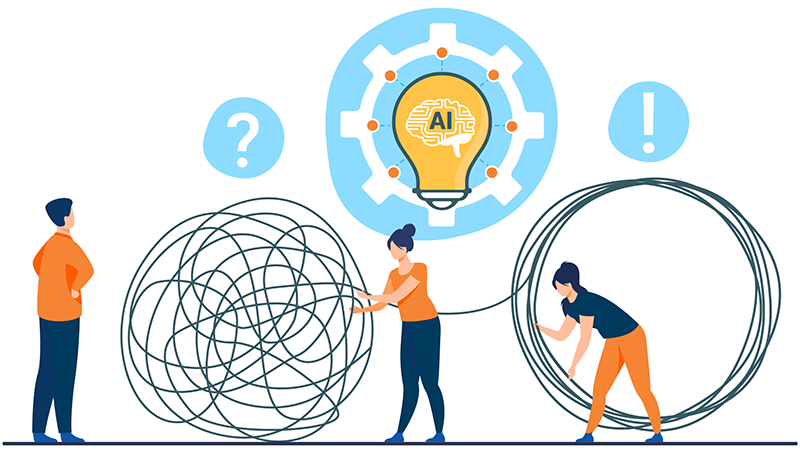MLOps stands for Machine Learning Operations and refers to the practice of implementing the development, deployment, monitoring, and management of ML (machine learning) models in production environments. The main aim of MLOps is to close the gap between data science and IT operations by applying certain principles and practices – from DevOps to ML workflows. Overall, MLOps involves the integration of tools and processes to ensure proper data preparation, model training, testing, validation, deployment, and monitoring, as well as continuous iteration and improvement of ML models. The ultimate goal of MLOps implementation is to make ML models reliable, scalable, secure, and cost-efficient.

In this article, we’re going to explain the importance of MLOps, provide an in-depth analysis of the main challenges related to the MLOps process, namely, data, models, infrastructure, and people/processes, and touch on the potential solutions that can help tackle these challenges.
The importance of MLOps
Let’s briefly expand on the importance of MLOps from the point of view of its goals.
Scalability
MLOps helps ensure that ML models are able to scale efficiently and can handle large volumes of data and user requests when needed. This is utterly important for applications that require real-time decision-making or processing of high-velocity data streams.
Reliability
With the help of MLOps, ML models should be by all means reliable and deliver consistent results over time. This is important for applications that require high accuracy, first and foremost, fraud detection and predictive maintenance.
Security
One of MLOps goals is to make ML models secure and protected against threats, including data breaches, cyber-attacks, and malicious actors that endanger applications dealing with sensitive or confidential data.
Cost-efficiency
MLOps helps to optimize the use of resources such as computing power, storage, and data bandwidth by automating processes and reducing manual labor. This can lead to significant cost savings for businesses that rely on ML models for decision-making and analytics.
Overall, MLOps helps businesses use ML models to their fullest through a well-ordered approach to managing the machine learning lifecycle, from the early stages of development to deployment, to maintenance.
Explanation of the MLOps process
Now is the time to say a few words about what the MLOps process looks like. There is no single conventional opinion on how many stages the MLOps process should be divided into – someone conditionally divides it into three parts, others into nine. For the convenience of the reader and at the same time for the sake of attention, we will divide it into the following four (plus one, never-ending) stages:
- Data Collection and Preparation;
- Model Training and Evaluation;
- Model Deployment;
- Monitoring and Management;
- Continuous Improvement.
Data Collection and Preparation
In this stage, data is collected and preprocessed so that it is of high quality, sufficient in quantity, and appropriate for training the models.
Model Training and Evaluation
In this stage, the ML models are developed and trained with the prepared data to be further evaluated and tested for their accuracy, performance, and robustness.
Model Deployment
This stage is all about deploying the trained ML models into production environments, where they can be used for real-time predictions or analytics.
Monitoring and Management
This stage involves monitoring the performance of the previously deployed models and managing them to ensure that they function as intended, including detecting and addressing issues such as data drift, model decay, and performance degradation.
Continuous Improvement
The last stage deals with the continuous improvement of the ML models by iterating on the data, models, and infrastructure.
To realize these stages, MLOps relies on a range of tools and technologies such as version control systems, continuous integration and deployment (CI/CD) pipelines, containerization, orchestration, and monitoring tools. The MLOps process also involves collaboration between data scientists, IT operations, and business stakeholders to ensure that ML models meet the needs of all parties and align with the overall business objectives.
Main challenges of the MLOps process
Data-related challenges of the MLOps process
Data-related challenges are inevitable, as the quality and availability of data significantly affect the accuracy and performance of ML models. For instance, poor data quality will likely lead to inaccurate or biased models that wouldn’t work out. For that, your MLOps team needs to do everything they can to keep data clean and relevant. Another data-related issue is related to privacy and security, which can be addressed by implementing security protocols, access controls, and encryption mechanisms. The data should also be easily available in sufficient quantity and quality to ensure the accuracy and performance of ML models.
Model-related challenges
The quality and performance of ML models are directly impacted by various challenges. First and foremost, the selected model should align with the problem(s) being solved and have sufficient capacity and flexibility to learn from the data. Then, ML models should be transparent and easily interpretable, particularly when they are used in sensitive or mission-critical applications. Another model-related issue you should avoid at all costs is model overfitting, which is usually a consequence of data-related issues (lack of data or much noisy data) and results in a failure to a good performance for all types of new data. Finally, your model can become obsolete or ineffective over time due to changes in the data or the environment – this is called model drift.
Infrastructure-related challenges
What many specialists overlook or take for granted is infrastructure. However, ML models require peculiar and stable infrastructure to be trained, tested, and deployed in a proper way. Oftentimes, ML models grow in size and complexity over time and, subsequently, require scalability of the infrastructure to handle their ever-increasing demands. Also, you should bear in mind that ML models require specific hardware and software to run efficiently, hence the importance of proper resource management. And, it goes without saying that the infrastructure should be monitored to ensure that it’s protected from system failures, resource shortages, or security breaches. Last but surely not least, ML models are built for a certain purpose, which means that they should be properly deployed and integrated with other systems in order to deliver business value – this is arguably the most important part of MLOps.
People- and process-related challenges
Streamlining the MLOps process takes coordinated efforts of multiple specialists, including data scientists, IT operations, business analysts, and stakeholders across various teams. The MLOps team should act as a bridge between all of them to ensure that they collaborate effectively. Then, MLOps must create consistent and convenient processes and workflows to help develop, deploy, govern, and manage ML models effectively.
Conclusion: possible solutions to MLOps challenges
Let’s wrap it up: MLOps teams face numerous challenges, including data-, model-, infrastructure-, people-, and process-related ones. To be fully armed and prepared to address them, MLOps teams can use various tools and platforms such as data management and governance tools, model versioning and testing tools, cloud computing and containerization platforms, project management tools, and communication and collaboration tools.
OptScale, an MLOps & FinOps open source platform, is designed for ML/AI and Data engineers and helps to overcome the most often challenges of the MLOps process. The solution optimizes the performance and cloud infrastructure cost.
OptScale is fully available under Apache 2.0 on GitHub →
💡 You might be also interested in our recent article ‘What is the best FinOps strategy or why having a FinOps team is a waste of money’, where our cloud experts destroy the myths about the general approach to FinOps adoption →
Discover:
● How many companies are really interested in building a process but not just an instant cost reduction and reflection of that in their P&L
● What the right size of the FinOps team is
● Real-life tips to build the right FinOps strategy
